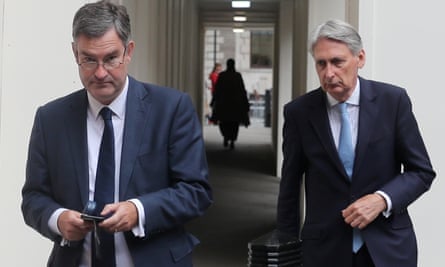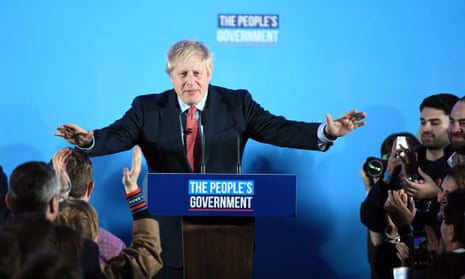A year on from Boris Johnson’s victory in the Conservative party leadership race, which ushered him into Downing Street, we look at the key moments of his time in office so far.
24 July 2019 – Sweeps into No 10, promising to defy ‘the doubters, the doomsters, the gloomsters’
The result of the leadership ballot of Tory members was announced to a packed Westminster conference centre on 23 July. Johnson beat Jeremy Hunt by a convincing 92,153 to 46,656. A parade of other rivals, including Matt Hancock and Andrea Leadsom, had been knocked out in earlier rounds of voting by MPs.
The next day, after Theresa May had led her final prime minister’s questions, Johnson paid the customary visit to the palace, and swept into No 10.
By contrast with the earnest tone of his predecessor, his first speech in Downing Street was a characteristic mashup of patriotic bombast and breezy optimism. “No one in the last few centuries has succeeded in betting against the pluck and nerve and ambition of this country. They will not succeed today,” he said, before disappearing behind the famous black door.
3 September 2019 – Johnson withdraws the whip from 21 Tory MPs, blowing up his own majority
Throughout the summer and early autumn, Johnson’s new administration was engaged in parliamentary guerrilla warfare with the “Gaukeward squad” of Tory rebels, who wanted to avoid a no-deal Brexit.
When Oliver Letwin secured a majority for an arcane parliamentary motion, paving the way for Hilary Benn’s bill that would ultimately force Johnson to delay Brexit, the prime minister expelled all the Conservative MPs who had voted for it.
They included nine former cabinet ministers, including Philip Hammond and David Gauke – and Winston Churchill’s grandson, Nicholas Soames. The purge underlined Johnson’s ruthless determination to take Britain out of the EU on his terms, and obliterated his slim majority, making an election all but inevitable.

12 December – General election victory
Johnson had won the support of a wary and demoralised Tory party by insisting he could win them a general election – and on 12 December he made good on that promise.
After a tightly controlled campaign featuring relentless repetition of his “get Brexit done” slogan, and few sightings of most of his cabinet, Johnson was returned with a thumping majority of 80, tearing through Labour’s post-industrial heartlands.
He hailed the result as evidence that leaving the EU was the “irrefutable, irresistible, unarguable decision of the British people” and promised those who had lent their vote to the Tories in traditional Labour areas: “I will not let you down.”
Jeremy Corbyn swiftly announced he would stand down as Labour leader, after a “period of reflection”.
31 January – Got Brexit done (sort of)
The prime minister had defied expectations and secured a Brexit deal with the EU27 in October, by signing up to a new Irish protocol – which effectively meant accepting a border down the Irish Sea, a compromise Theresa May was not willing to countenance.
He was then forced to delay Brexit until January by Hilary Benn’s rebel legislation, which required MPs to approve a deal before the UK could leave.
But with a comfortable majority after the general election he was able to push his “oven-ready” deal through parliament, allowing the UK to leave the EU on 31 January. The prime minister marked the occasion with a party for close allies in Downing Street, at which he sipped English sparkling wine and sounded a small gong.
His deal left many questions about the UK’s future trading relationship with the EU to be thrashed out in negotiations. But with Brexit “done”, Johnson moved on to a ruthless reshuffle that caused his chancellor to resign rather than accept No 10 tightening its grip on the Treasury.
23 March – Stay at home
Stripped of his habitual bonhomie, a sombre Johnson delivered an unprecedented broadcast message, urging the British public to stay at home to protect themselves from coronavirus.
The full lockdown followed an intense period of escalating public health measures, which took the prime minister in little more than a fortnight from a message of “wash your hands and business as usual”, to “stay at home, protect the NHS, save lives”.
Just four days later, Johnson announced he had contracted the virus himself; and on 7 April his condition had deteriorated so much that he was taken into intensive care, where he would remain for three anxious days.

26 May – Dominic Cummings’ press conference
Johnson leaped to the defence of his chief adviser, Dominic Cummings, after the Guardian and Daily Mirror revealed he had driven 270 miles to his parents’ property in Durham at the height of the coronavirus lockdown.
With questions about Cummings’ conduct refusing to die down, and a number of Conservative MPs expressing concern, the insouciant former Vote Leave director gave an extraordinary press conference at a table in the No 10 rose garden.
Cummings claimed he had taken the cross-country journey to secure childcare for his four-year-old son – which he did not eventually use – and that a side-trip to Barnard Castle was to check if his eyesight was good enough to drive back to London.
The explanation was met with incredulity across a nation wearied by lockdown, and protests from many MPs – but Johnson stood by his right-hand man, underlining how indispensable Cummings had become.

17 July – Prepare for the worst, hope for the best
With a return of some of his trademark optimism, after weeks in which some colleagues had feared he had not fully recuperated from the virus, Johnson held out the prospect of a “significant return to normality” by Christmas.
He encouraged the public to return to their workplaces from 1 August if employers believe it is safe to do so, and added ice rinks and bowling alleys to the long list of businesses – including pubs and restaurants – that have been allowed to reopen.
However, at the same time Johnson announced he would be setting aside an extra £3bn to help the NHS manage through a potential second wave this winter. “Even as we plan for the worst, I strongly believe we should also hope for the best,” he said.
